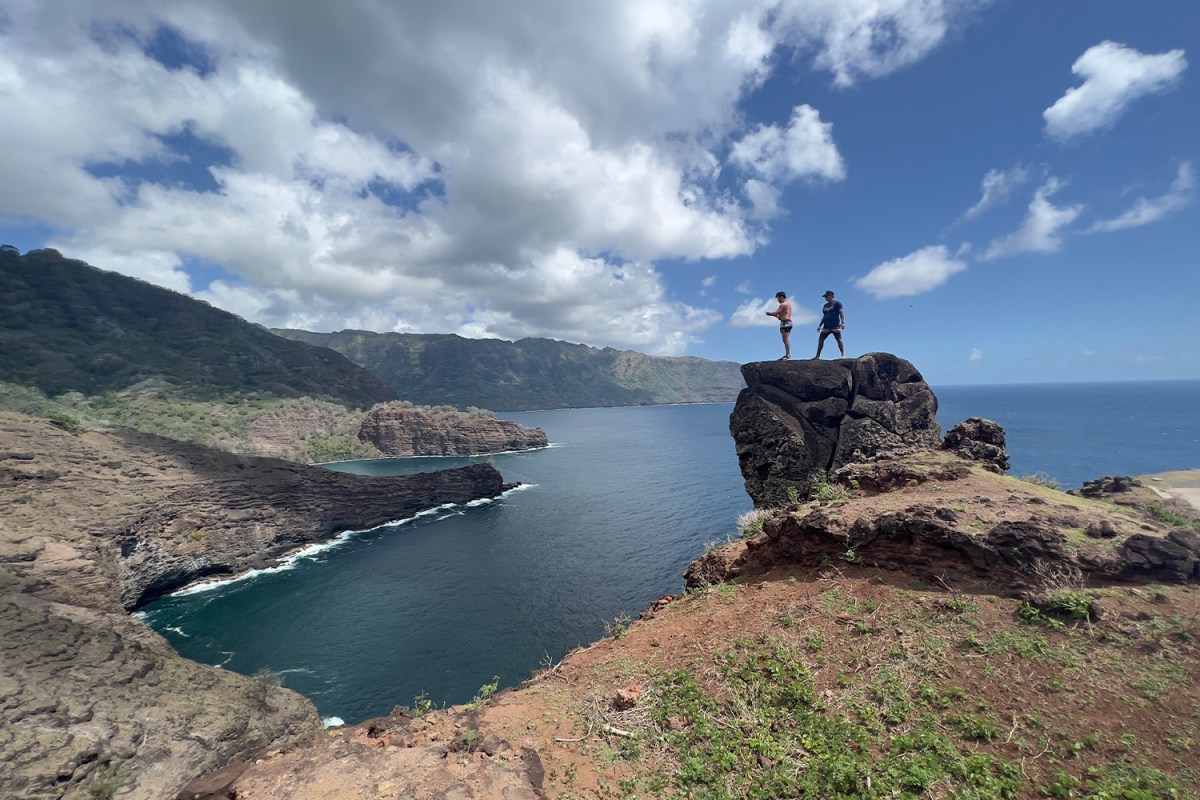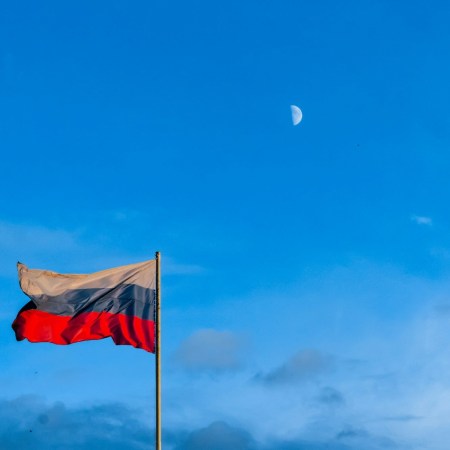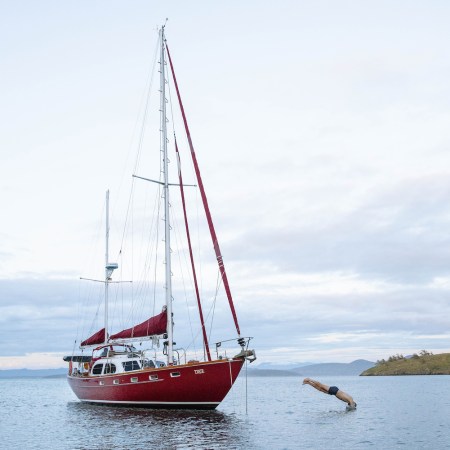Two years ago I visited French Polynesia for the first time and choreographed a dance number with a curious baby humpback off the island of Moorea. We encountered the calf relaxing with his mother in shallow, cobalt blue waters before their yearly migration to the nutrient dense depths of Antarctica. Rising up for air he approached our group and engaged us as only a playful, sentient being could. Wanting to impress my new friend, I initiated a game of spinning which he immediately imitated. As soon as we both completed a perfectly executed pirouette he turned in my direction, observing carefully with eyes that conveyed understanding and waited for further instructions. The games went on for several minutes before his mother surfaced, dwarfing him as he had dwarfed us, and escorted our playmate to deeper waters. In those life changing moments of interaction with an intelligent, wild animal I became soulfully hooked on these islands.
Earlier this year I came back with a film crew and spent two weeks in the Tuamotus archipelago filming an episode of Discovery Channel’s Shark Week. My job was to swim with tiger sharks and various other species till my hands were pruned and a patina of salt became my uniform. During the day I hung out on deserted beaches and ate lunch before returning to “work” under the waves to study thriving marine ecosystems. At night I marveled at the stars then retreated to my cabin on the catamaran, our floating home office, as it traversed between pristine coral atolls.
The five archipelagos that comprise French Polynesia are tremendously varied in topography, marine habitats and culture — and cover an area of the Pacific five times the size of France: The Society Islands, Tuamotus, Gambier Islands, Marquesas, and Tubuai Islands. Americans are most familiar with Bora Bora, a member of the Society archipelago, as a swanky honeymoon destination which is truly worth the hype but by no means the only gem this island nation has to offer. If you set your sights on more off the beaten path destinations then the lesser known archipelagos are not to be missed. The majority of the 118 islands fly so under the radar that The Islands of Tahiti, as French Polynesia is often referred to, famously get as many visitors in one year as Hawaii does in a week, an astounding statistic quite frankly.
The Marquesas have always fascinated me — sparsely populated, fierce, wild, enigmatic. Their remoteness, rich history and promise of escape from the fluff of modern life piqued my interest long ago. Learning that roads on the two main islands, Hiva Oa and Nuku Hiva, were paved a mere six years prior and cell phones were introduced shortly after sealed the deal.
As a fan of author Herman Melville, I fantasized about such explorations that led him to write Typee in 1846 after wandering the Taipivai Valley on Nuku Hiva in search of tribes that he was both intrigued by and fearful of. Ultimately, lost and sick, Melville and his companion were welcomed by the Taipi clan and instead of being eaten, as expected, were nursed back to health and sent on their way. A rather cheerful ending to an adventure that has gone poorly on numerous occasions in the annals of history. This seemed the perfect destination post-intensive film schedule, so my producer Justin and I hopped the three and a half hour flight from Papeete to follow in the footsteps of renowned explorers and creatives.
For centuries the Marquesas were a land so steeped in mystery that the crew of the ill-fated Essex — which was rammed by a sperm whale and sunk — chose to head for distant South America for fear of legendary cannibals that inhabited these islands. In one of the most unfortunate and ironic disasters in nautical history, they avoided the nearest land only to turn to cannibalism themselves in their life boat. This harrowing drama was immortalized in the classic Moby Dick, written by Melville in 1851. The whale might have been fictionalized, but the story was a true tale with a calamitous twist.
In the 1900’s, artist Paul Gauguin and later, musician Jacques Brel, came to the Marquesan island of Hiva Oa in search of inspiration and solitude. Gaugin’s sexual appetite and exploitations were as infamous as his art, and despite having a well-deserved place as a post-impressionistic creative his personal escapades have not earned him a beloved place in local history as evidenced by his stark and undecorated grave. On the other hand, Brel’s resting place, a few feet from Gaugin’s, is overflowing with fresh flowers, personalized notes and photographs, a reminder that the legacy you leave behind is not quickly forgotten.
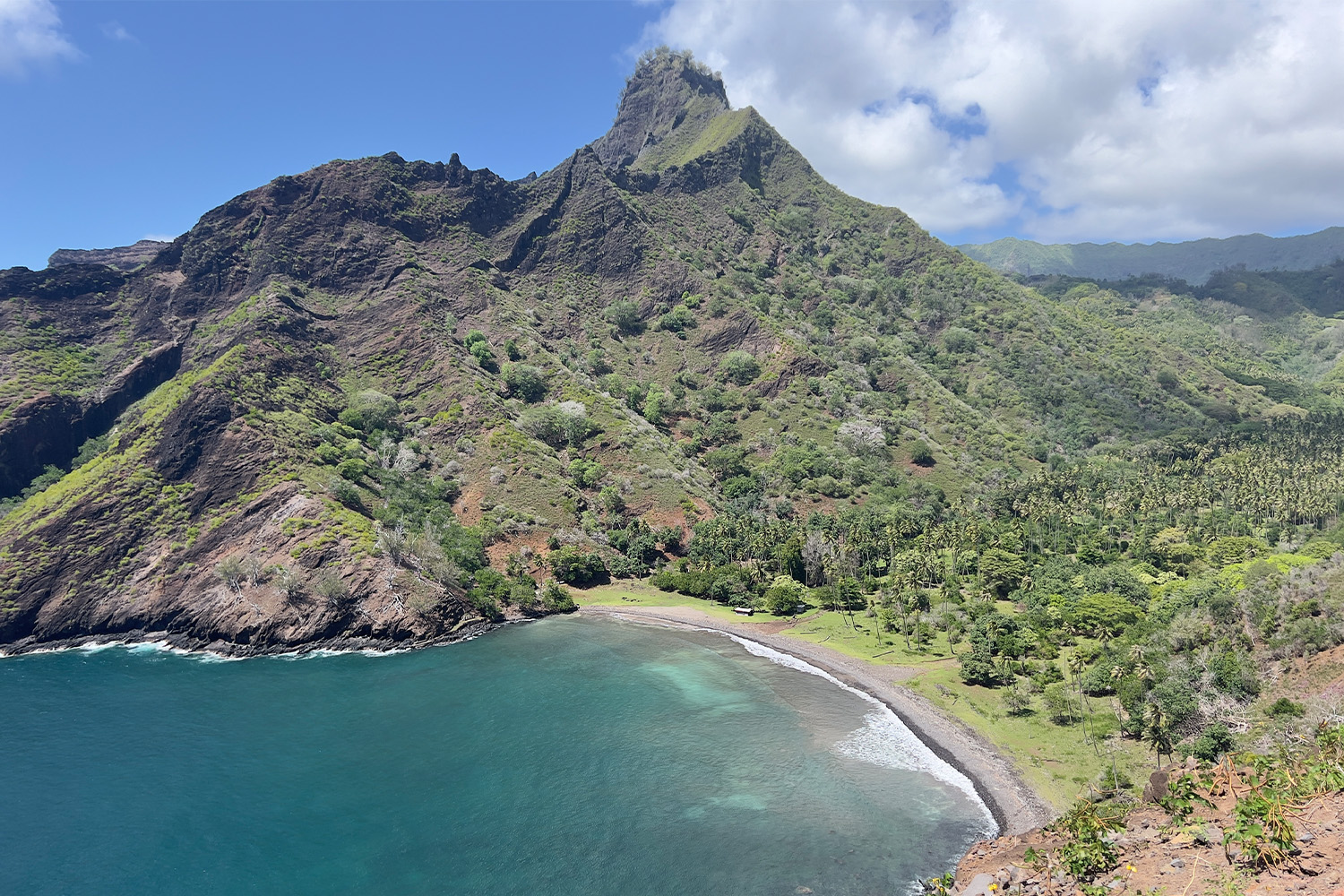
Touching Down In the Marquesas Islands
The landing in Hiva Oa is a fitting introduction to the nature of this land — rugged. Our small plane descends next to the stegosaurus-like spine of an ancient caldera often shrouded in clouds as if we might be arriving on an island concealing a dinosaur theme park. The dominant color is a rich green. It could be mistaken for Hawaii if it wasn’t for the obvious lack of tourists and tiny, open airport that often suffers flight delays when the Wi-Fi isn’t working. At nearly four hours from Papeete in the direction of South America, the Marquesas are nothing if not isolated. In addition to the limited number of flights, some travelers of the saltier variety arrive by boat from the Americas on a cross-Pacific journey not unlike old world explorers.
Accommodations are limited to one main hotel, the Hiva Oa Hanakee Lodge, and a spattering of guest houses, known as pensions, which once again reaffirms we came for remoteness and that’s what we got. The locals are renowned for their welcoming nature and Tanya, our hostess, had a smile that could launch a thousand ships — and probably has.
We spent two days traversing the winding roads of a land that time forgot with our guide Jonathan of Hiva Oa Adventures. Each turn revealed another sparkling bay and coconut palm filled valley seemingly untouched by human endeavors. Empty beaches and cloud rimmed mountains were our constant companions while the nearest all-inclusive resort was 900 miles away.
From stone carved Tiki and elaborate ceremonial spaces to a spine-tingling history of tattoos and trees that are keepers of the gates to paradise, the Marquesas are a world of intrigue and mystery. The men in Hiva Oa spearfish only at night, have the spirit of ancient warriors and tell the stories of their land and ancestors with the intricate designs inked in their skin.
On these volcanic outcroppings, set in emerald green waters, exists history that often dips into the realm of myths and legends. At the core of some of the most fascinating lore is the banyan tree. It is associated in many cultures with spirituality and death, maybe because of its own origins as a strangler fig — a seed landing on a host tree and ultimately engulfing its support structure with hundreds of aerial roots. Here, legends tell us that the banyan determined whether chiefs and warriors were released to paradise. The deceased were placed in outrigger canoes and secured amongst the banyan’s roots. If, after a period of time, the tree grew around the dead they were kept on earth and buried. If the tree did not embrace them, they were set free to the great beyond and the body was ceremoniously thrown to the ocean, the gateway to utopia, along with food items like pork and breadfruits, and, for good measure, slaves captured from other tribes to serve them in the afterlife. The sacred trees were nourished with the bones of commoners so every member of the tribe would ultimately have their communion with the arboreal spirits.
Religion aside, I appreciate the idea that a tree could have the power to decide my fate after death or that I might be fertilizer for such a magnificent living thing. It’s a rather beautiful thought and one that has made its way into modern life with the rising popularity of biodegradable burial pods designed to nourish trees.
Jonathan brought us to a precarious perch called Virgin Rock, on which the unfortunate were dispatched with a fierce U’u’ war club and tossed beneath the waves ahead of the dearly departed. Their job was to lead the way into the hereafter, paddle the outriggers and serve them faithfully in death. The human sacrifice practice was halted by missionaries who tend to frown upon such things so the practice shifted to using feral pigs. In 1987, French explorer, Jacques Cousteau, visited the Marquesas aboard his research vessel the Calypso. Intrigued by stories of rituals and sacrifice he procured a submarine to explore the bay. There he found what was described to us as “piles” of human remains topped by a layer of pig bones, confirming the legends.
On the interior of the island we visited ceremonial platforms of astonishing complexity, stones indented by countless strikes of tool makers weapons and depressions in which ink for tattooing was mixed. The art of Marquesan tattoos is distinctly different from Tahitian and represents not only history and personal stories, but also the collective strength of the people. The Marquesans are the epitome of survival of the fittest. In tribal days fifty percent of the population died from infections caused by tattooing which makes it seem a rather unnecessary practice, but the Marquesans saw it as a sorting of the strong from the weak. A Darwinian example of natural selection so that only the strongest individuals with thriving immune systems advanced in the gene pool.
From infections caused by tattooing to tribal war and lack of food in difficult years, weakness was not a trait that passed the test of life on these unforgiving islands. Like so many isolated communities, it was ultimately disease brought by seafarers that took the greatest toll. Yet even after entire tribes were wiped out by visiting explorers and missionaries, the population made a comeback and their reputation for survival and fierceness became, in part, a strategy to keep outsiders away.
The most fascinating windows into the past are the tikis. Buried deep in the jungle there were once hundreds dating back to the 13th century, now only a few remain as most were confiscated by early expeditions and unceremoniously taken to museums and private collections. The humanoid figures carved into stone embody ethereal entities of nature. From wind and waves to abundance and knowledge, the tikis were (and still are) key elements of the rich tapestry of local culture. One of the most well-known is smiling tiki, although it is now believed it’s not smiling but rather speaking, singing or organizing a ceremony. This particular tiki is thought to be a woman, a leader of her tribe, representing femininity and shared knowledge.
Some of the more exceptional examples include carvings of animals which look strikingly like South American alpacas, a creature not found on the Marquesas, and would seem to indicate seafaring explorers from the islands had reached distant shores and come back with knowledge of lands far beyond their own. Historians generally agree that Marquesans were also the first to settle Hawaii around 400-500 AD bringing with them much of their culture and traditions.
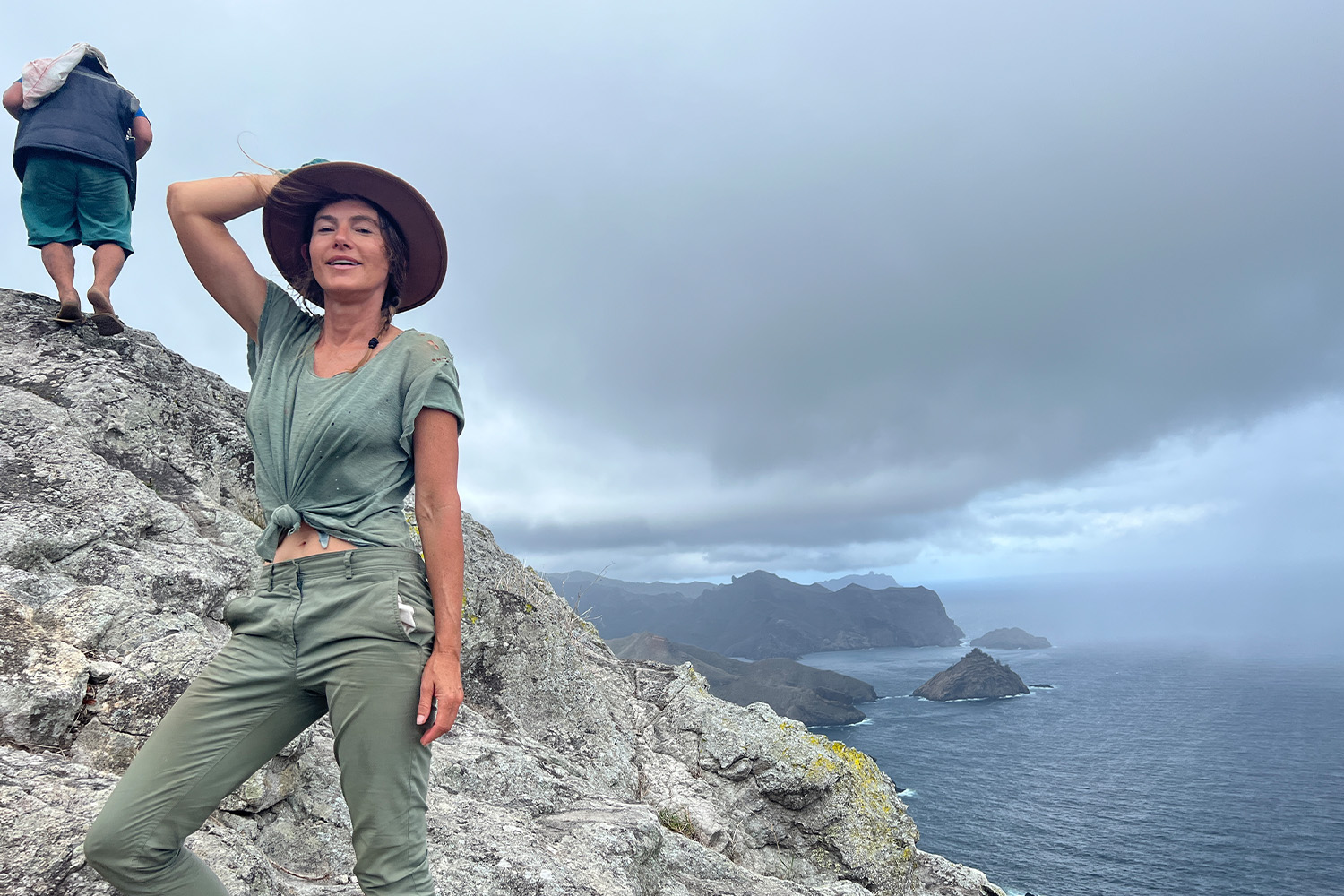
Unexpected Adventure on Nuku Hiva
Our next Marquesan island was Nuku Hiva. Landing on the leeward side is deceptive, giving the illusion that this island is dry and infertile. But this island — the largest of 12 in this archipelago, and one of the six that are inhabited — is as diverse as it is extraordinarily cinematic. Our local guide, Aniata, picked us up and we circumnavigated the island on dirt 4×4 tracks, stopping occasionally to move boulders off the road and enjoying the vistas that changed dramatically with every turn.
To quench our curiosity, Aniata elaborated on the island’s historic reputation of cannibalism. Indeed it was practiced, but with caveats. Only chiefs, warriors and leaders were allowed to consume human flesh. Spiritually significant organs were the ones ceremoniously eaten: the brain, eyes and tongue. Mana, life force, resides in the head therefore that area of the body is particularly revered. To this day it is inappropriate to touch someone’s head here, especially children, as it could disturb their soul. Hair is regarded as sacred and those abiding by ancient traditions and superstitions still cut their own and bury it in the yard to prevent anyone with ill intent from using it to cast spells.
Our drive to the main village of Taiohae continued through lush valleys and along the coasts of numerous bays. We stopped along the way to pick fruit and watch a family of wild pigs chew on a coconut without concern for our presence. Much of the fruit, including the ubiquitous coconut palms, was introduced as a food and revenue source. The same is true for goats and pigs. Wild herds of goats roam the hillsides and their meat is a local delicacy prepared with coconut milk or curry.
We passed the primeval valley through which Herman Melville ventured and on the much more recent side of pop culture, the bay where Survivor Marquesas was filmed in 2001. In the main village of Taiohae, lodging options are the Nuku Hiva Keikahanui Pearl Lodge or the pensions. We opted for the latter and stayed with our guide’s family at Koa Koa lodge which was a cozy bedroom in their home, complete with several dogs, a vocal cat, a lovely garden and a balcony overlooking the bay. As charming as the Pearl Lodge is, nothing compares to sitting at dinner with a local family and learning the history of the island from those who call it home.
As it turned out, the unexpected highlight of our stay on Nuku Hiva was facilitated by our pension hostess, Debora, who took to heart our desire for authentic participation in daily life.
She arranged a horseback ride for us to experience the dramatic scenery in as immersive a way as possible. In general, trail riding in the U.S. is something I find to be a lackluster, manicured adventure with waivers and helmets and guides that take every precaution of safety in an attempt to avoid litigation. Boring quite frankly. But the views were sure to be exceptional so we were optimistic. As it turned out, my concerns of a gentle nose to tail ride were unfounded and the “immersive experience” was far more than we bargained for. There were no questions about ability, examination of riding shoes, agreeing not to hold anyone responsible in case of death or dismemberment or quite frankly anything other than a quick saddle adjustment. I observed our guide, dressed in well worn flip flops and a bucket hat, strapping a shotgun to his saddle which piqued my interest as there are no large predators on the island, but I trusted that he had his reasons.
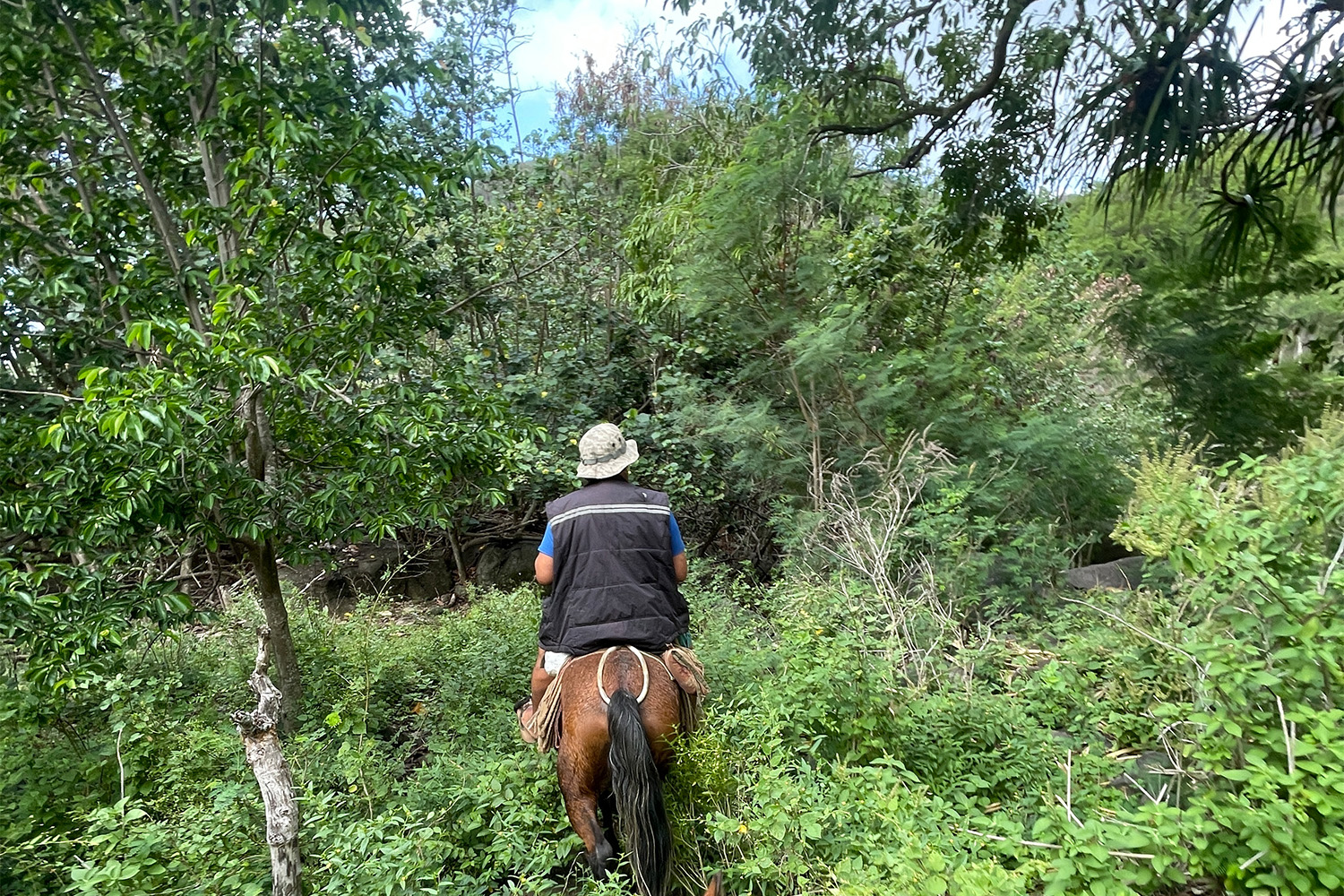
Teiki Paatai was our guide’s name and he spoke no English. My travel partner, Justin, and I spoke neither French nor Marquesan so communication consisted of pointing, smiling and the universal OK sign. The trail wound through moss covered trees, under low hanging branches and along switchbacks up the side of a mountain towards an endless sea of green. Soon it vanished altogether and we climbed rocky escarpments and down muddy slopes to the sound of birds, wind and rhythmic hoof beats. As the terrain intensified our horses performed acts of parkour, and on more than one occasion I surfed my horse down a hill as it slid in a squatted position until it regained its footing inches before a drop-off. Justin and I remarked with each near miss that this was phenomenal yet not an adventure most tourists without extensive riding experience would consider within their comfort zone. (By extensive I mean the stunt cast of Yellowstone.)
At the peak of the first mountain Teiki stopped and showed us a view that would impress even the most unenthusiastic couch potato. The valley from which we had come nestled into an ancient caldera, the vast natural harbor with its two jutting peninsulas that Debora had described as a mother’s arms protecting the fragile humans living on her land, and above us more cliffs. We rode on. When the rain started we sheltered under a large banyan tree covering our saddles and belongings with burlap sacks. Here is where we learned the word, “glis.” Teiki showed us with his foot that the earth was slick and said the word until we understood that we needed to walk our horses along the narrow cliffside path so if a horse lost its balance on the wet soil we wouldn’t be on its back if it fell. Horses are sure footed animals and I trust their innate survival instincts immensely, but in a situation where you have massive drop-offs on either side, personal survival instincts insisted on trusting my own two feet instead.
On we went, climbing escarpments, descending hills, meandering through saddle high ferns with untouched beauty all around us. After hours of riding through terrain that was more conducive to mountain goats than horseback riders, our guide stopped on a ridge the width of a yoga mat with steep drops on either side. He put his hand up to indicate silence. With surprising agility Teiki jumped off this horse and grabbed his rifle. Along a wooded ledge ran a herd of goats. I understood what was going to happen next and my mind focused on controlling the horses when he fired. I watched him squat and put the rifle to his shoulder. Our horses were lined up on the thin ridge with no room to move if they bolted. These horses are most likely familiar with gunfire, my mind reasoned, but our precarious perch seemed to outweigh that small comfort. I shouted at Justin to hold his horse or get off and let go if it ran, but his self-preservation instincts had already kicked in and he had already dismounted.
The gunshot rang out and the horses startled. For a split second the situation could have gone awry, but Able to successfully control them, and having not plummeted to a dramatic end, a wave of pure focus came over us. We ran after Teiki who outpaced us in flip-flops, jumping from rock to rock with the ease of his prey. Below us, on a plateau, lay the goat. Ten feet further was yet another immense cliff. Carefully, the three of us made our way down, using branches for balance to keep from sliding on the loose earth towards the ledge. My fear of heights made my head spin and my knees weak but I couldn’t miss this experience. Right there on the plateau, Teiki expertly gutted and beheaded the goat, tossing the animals head and entrails off the ledge, then slung it over his shoulders and scrambled back up with ease as we picked our way gingerly looking for handholds like we were free soloing Half Dome. He quartered the meat, showed us with pride that a single bullet pierced the lungs and heart killing the animal instantly and packaged the bounty onto the horses.
We rode on, a little less comfortably, as my saddle was now shared with the goat and a hoof was digging into my backside. An hour later the entire scenario repeated itself except this time the precipice was much bigger and the goat plunged over the edge. We followed Teiki, once again picking our way down jagged basalt escarpments. Our search was unsuccessful. Marquesans have immense respect for the goats as a food source and wasting an animal is upsetting. He walked back to the horses, rifle slung over his shoulder, and I felt deep sadness for the loss, both animal and human. The goat was food for his family. We rode back several hours through alternating rain and sunshine in silence, tired yet filled with boundless gratitude for such an experience.
That night over dinner at our pension we learned that Teiki had buried his wife the day before. He was not a tour guide but a local hunter who was generous enough to invite us into his world and give us an authentic glimpse into Marquesan life. Our goat hunting adventure was his grocery run. I still have the bullet, and every time I look at the memento I smile recognizing that to Teiki it would be like keeping a receipt from Whole Foods. The sole similarity being free range, grass fed meat.
This article appeared in an InsideHook newsletter. Sign up for free to get more on travel, wellness, style, drinking, and culture.
